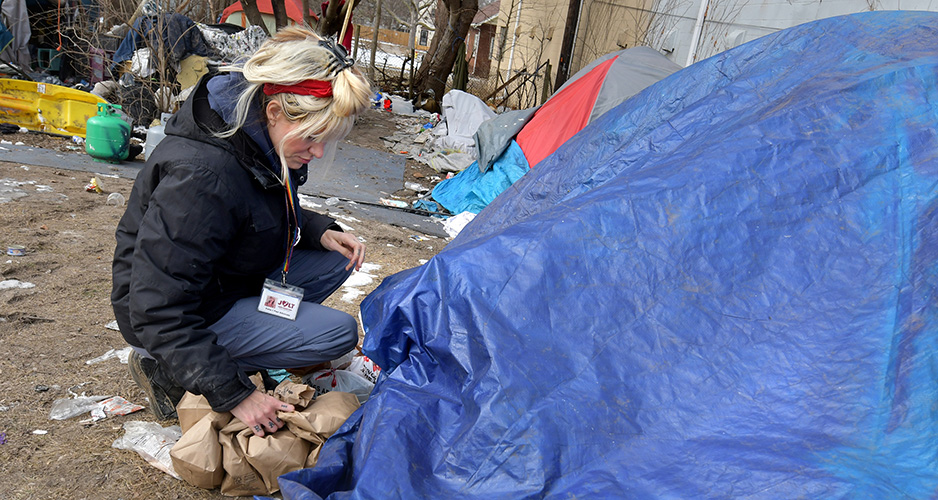Regarding Downtown’s homeless population, ‘a little respect can go a long way,’ but it cuts both ways
John Kittinger sees two faces of Downtown homelessness.
There’s the glower from business owners and customers quick to judge street people as scary and polarizing. And there’s the indifference of panhandlers and others who sometimes show little respect to businesses, passersby and surroundings.
Kittinger has witnessed this head-butting dynamic first-hand. Of his 57 years, more than a decade has been spent on the streets of Peoria.
“I’ve seen both sides,” Kittinger said. “People can be cruel to the homeless. But the homeless cause a lot of their own problems.”
Downtown faces a growing conundrum in balancing the rights of businesses and the homeless, both of which want to survive.
“How do we find a middle ground that meets all needs?” said Chris Schaffner, executive director of Jolt Harm Reduction, which works with people struggling with drugs and other problems, including homelessness.
Getting help, helping yourself
According to official estimates, Peoria’s homeless population numbers about 70. However, that demographic is hard to pin down for exact counting, and thus that total is likely low, Schaffner says.
Still, he says, about half of the city’s homeless congregate and live Downtown, which is conveniently located near many social-service agencies, along with the bus station. Plus, the high-traffic intersections are attractive to panhandlers, though not all of them are homeless.
“Some are (employed workers) just trying to supplement their crappy income,” Schaffner said.
Still, panhandling discourages fun-seekers from visiting Downtown, according to businesses there.
“Many (people) won’t want to come down and deal with the constant panhandling,” said Kelly Revallo, manager of the Neon Bison, a saloon at 514 Main St. “Many of these homeless are suffering from mental health and/or drug issues, so that makes some of them very unpredictable. So, it has been a struggle at times to convince neighboring areas that it is safe to enjoy our Downtown nightlife.”
Next door, Janine Cook, owner of Hoops Pub and Pizza, 516 Main St., shares a similar concern about a lack of mental-health care for many of the homeless people she sees congregating around her front entrance.
“Homeless people bother customers by begging for money,” she said. “They also take up our outside seating.”
Kittinger said he witnessed such behavior during his stints on the street, which happened during a years-long tumble into drugs, booze and prison.
“A lot of them leaves messes, like, outside the (homeless) camps,” Kittinger said. “A lot of them need help. But they’ve also got to help themselves.”
For his part, Kittinger says he strove to be respectful. He did not get confrontational with passersby, and he did not leave trash behind. However, his conscientiousness did not matter to many business owners and pedestrians, who just at the sight of him, often would shoot him nasty looks.
“I didn’t have any disease,” he said, ruefully. “You couldn’t catch anything from me.”
Kittinger is sober and no longer living outdoors. He recently found subsidized housing and a restaurant job. His upturn included assistance from Jolt, which is based at 2203 N. Sheridan Road but works throughout the city. He calls his current path more stable and peaceful.
“I’ve made some bad decisions,” he said. “(But) I’ve learned some things, from Jolt and from being on the street.”
No easy solutions
Downtown, social-service agencies offer emergency shelter and other housing. Plus, Phoenix Community Development Services is spearheading a 55-unit permanent supportive housing development aimed for Downtown at 415 St. Marks Court.
But not all homeless can adapt to new surroundings as easily as Rettinger. Many have a hard time conforming to rules — such as a ban on alcohol — at some residential sites.
“People want to have self-determined lives,” Jolt’s Schaffner said.
Moreover, a new residence is no panacea.
“There’s a myth that if you house someone, all their problems will vanish,” Schaffner said.
To a large degree, many of those problems involve mental-health issues, which can include years of trauma. Plus, many other challenges come from street-life experience. For instance, because of food insecurity, many homeless have become hoarders, a habit that translates poorly to apartment life. Others have been in survival mode, which makes it hard to transition to social situations. And others feel guilty getting a residence while knowing friends remain unhoused.
Amid all those possible problems, the Heart of Illinois United Way’s Home for All Continuum of Care seeks deep-reaching solutions to homelessness.
“While the answer to homelessness is affordable housing, it is also important to work toward long-term stability for individuals and families who experience homelessness,” said Kate Green, executive director of the Continuum, which coordinates the help of multiple social-service agencies.
“This means that our network includes not only our funded agencies who conduct street outreach and provide shelter and housing options, but also education providers, the health care systems, criminal justice representatives, and many more.”
But that work has become even harder of late.
“Throughout our community, we all have been impacted by inflation and adjusting to life post-COVID-19,” Green said. “These conditions have left many people struggling to make ends meet. We have seen local numbers rise, especially in terms of families experiencing homelessness.”
To the rescue
The increase in homelessness did not go unnoticed at Riverside Community Church, 207 NE Monroe St. Noting soup lines and food banks elsewhere, the church decided to add something new: the outdoor Riverside Peoria Fridge, which offers free milk, cheese, fruit and other staples six days a week.
“We try to keep the fridge stocked,” said Michael Ritchason, the church’s lead pastor. “But with 150 people coming a day, food can vanish in a half-hour.”
How else can people help? Jolt’s Schaffner advises against dropping off donations at homeless camps, as an overabundance of items (food and otherwise) can foster waste piles conducive to rats and other vermin. Rather, a donation to a social-service agency likely offers the biggest bang for the buck.
Meantime, for businesses confronted by homeless people, Schaffner is distributing a guide called the “Homeless Tool Kit,” as yet not available online. Among the suggestions:
Offer to call Heart of Illinois 2-1-1 to coordinate health and other services.
Refer them to Phoenix Community Development Services for housing assistance: 309-674-7310.
Contact Jolt for immediate needs, such as tents, blankets and sleeping bags: 309-966-3643.
Further, though Schaffner recognizes the rights and needs of businesses, he suggests that people including business owners get involved in the organizations and agencies helping street people. In fact, any act of kindness could help business-homeless relations.
“Get to know the people living on the streets in your area and treat them in a way that makes them like and respect you as a good neighbor,” Schaffner said. “A little respect can go a long way.”
For more information on homeless assistance programs:
Jolt: joltfoundation.org
Continuum of Care:
homeforallcoc.org
Phoenix Community Development Services: phoenixcds.org
Heart of Illinois 2-1-1:
hoiunitedway.org/heart-of-illinois-united-way-2-1-1
Riverside Peoria Fridge: riversidepeoria.com/fridge





